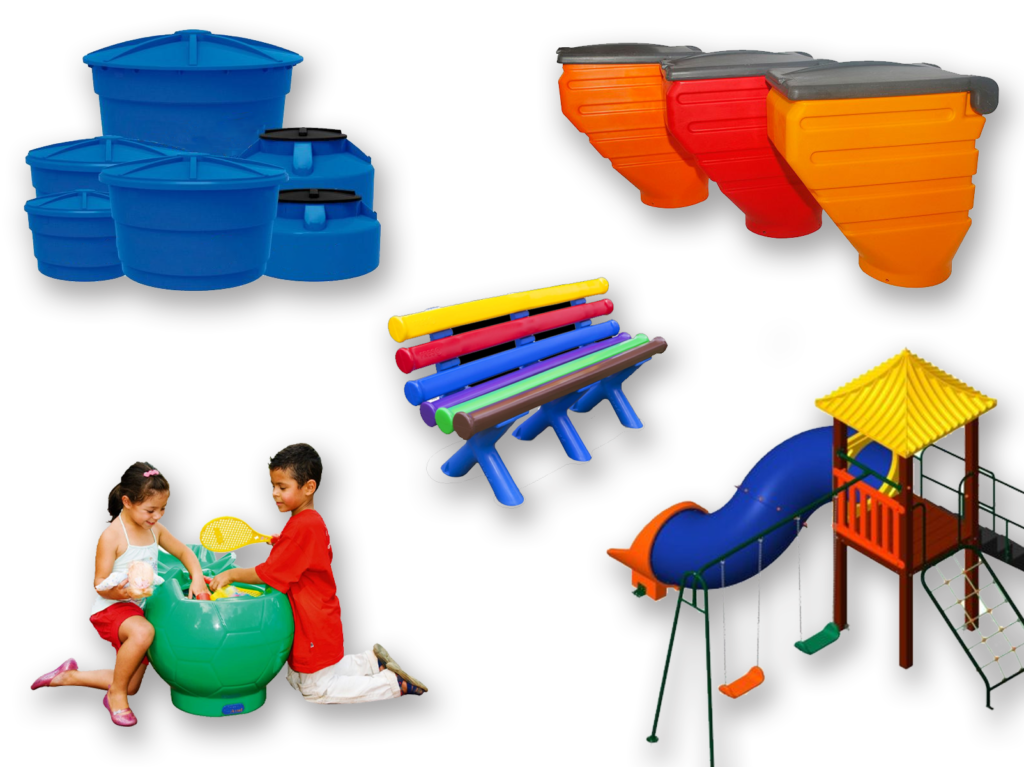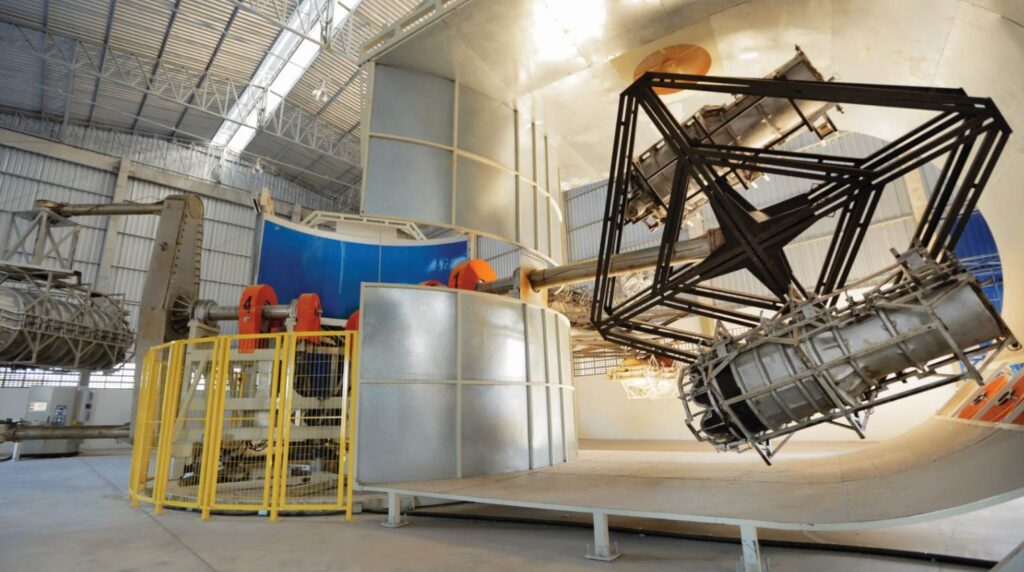WHAT IS ROTATIONAL MOLDING
A Rotomolding is a revolutionary process that allows for the creation of complex objects using plastic. The ability to create unique shapes, sizes, and textures, along with a variety of durable plastics, makes rotational molding the answer for producing customized items for any type of need.
IN THIS ARTICLE:
In this article, we will discuss the following topics: the history of rotational molding, the main industries that utilize it, and the benefits that this process offers. So, get ready to learn everything you need to know about rotational molding!
HISTORY OF ROTATIONAL MOLDING
The Plastic Rotomolding technique was first patented in the mid-1850s by R. Peters in Britain.
A partir do fim dos anos de 1950, a utilização comercial da Rotomoldagem de Plástico para a produção de diversos tipos de peças teve início. Nos anos de 1950, começaram a utilizar o plástico como matéria-prima no processo de Rotomoldagem. Inicialmente, as indústrias empregavam amplamente a Rotomoldagem na fabricação de peças com finalidades industriais, como tanques de combustível, componentes para as indústrias automobilística e agrícola, e recipientes de armazenamento. Com o tempo, o processo foi se ampliando para outros setores, como por exemplo, o de brinquedos, móveis, equipamentos esportivos, entre outros.
Popularization of rotational molding
The process of rotational molding gained popularity over the years due to its advantages, such as the ability to produce large-sized parts with complex shapes without the need for expensive molds.
With the advancement of technology and the development of new materials and equipment, rotational molding underwent constant improvements over the decades, resulting in increased efficiency, quality, and versatility in the production of plastic parts.
Rotomolding today
Atualmente, a Rotomoldagem de Plástico é uma técnica de fabricação amplamente utilizada em diversos setores da indústria, such as automotivo, agrícola, embalagens, rotomolded, móveis, entre outros.
It is considered an economical and sustainable option for the production of plastic parts due to its efficiency and low material waste.
MAIN INDUSTRIAL SECTORS THAT USE ROTATIONAL MOLDING
Rotational molding is widely used in various sectors of the modern industry. Due to its flexibility, it allows the production of resistant and durable materials.
Ela tem sido amplamente utilizada para produzir barcos, tanques industriais, móveis personalizados, partes de veículos, produtos voltados ao mercado de lazer e bens de consumo.

Plastic Rotomolding Process
Vamos adentrar nos detalhes do processo de rotomoldagem. Cada etapa desse método desempenha um papel vital na criação de produtos plásticos. Vamos analisar, por exemplo, como a rotomoldagem se destaca como uma técnica de fabricação única, promovendo eficiência e versatilidade na produção de peças plásticas.
Material Preparation
The rotational molding process begins with the preparation of the plastic material. The plastic is first granulated and/or ground to ensure uniform-sized particles.
Next, the team blends the particles with additives, such as pigments and release agents, according to the product design.
Material in the Mold
Next, we place the mixed material inside a mold, which represents the desired shape of the product. Then, we rotate the mold to ensure that the plastic is evenly distributed within the cavity.
Heating in the Rotational Molding Machine
Once it evenly distributes the plastic, the machine heats and cures the piece at a specific temperature and for a defined period of time.
The time and temperature of the curing process vary according to the type and hardness of the plastic.
Internal
After this stage, we cool the mold to room temperature and/or with the help of cooling fans so that the plastic solidifies in the desired shape.
Finished Product
Finally, the finished product is removed from the mold cavity and is ready for use. The rotational molding process is an efficient and economically viable way to produce high-quality plastic products.
In the video below, you can see more about the rotational molding process.
PARAMETERS FOR ROTOMOLDING MACHINES
To determine the size and quality of the final piece, most rotomolding machines use important parameters. Among these parameters, the material used, oven temperature, rotation speed, and other relevant variables stand out. These elements play an essential role in configuring the process, contributing to achieving consistent results and meeting specific production requirements.
Material
Selecting the material influencia diretamente no funcionamento da máquina de Rotomoldagem. Este parâmetro varia desde materiais reciclados até componentes especiais, impactando nos processos envolvidos. Em termos práticos, o tipo de material selecionado para a moldagem não apenas determina o custo, mas também influencia o desempenho e a durabilidade da peça resultante.
Temperature
The oven temperature is also an important parameter. If the mold is not at the proper temperature, the rotomolding process will not be successful. In other words, the oven temperature can also affect the quality of the final product.
The overheating of the plastic material can result in excessive melting, leading to parts with deformities, distortions, or even burns. Additionally, very high temperatures can increase the risk of premature mold wear and negatively influence the consistency of material distribution. This can result in variations in the thickness of the part's wall and affect its final properties.
At inadequately low temperatures, the plastic may not achieve complete fusion, resulting in parts with a lack of cohesion and strength. Additionally, the uniform distribution of the material may be compromised, leading to irregularities in the thickness of the part's wall. This can result in final products of lower quality with compromised mechanical properties.
Rotation Speed
A proper rotation ensures the uniform distribution of the plastic material, resulting in final pieces with consistent wall thickness. On the other hand, if the speed is too low, the plastic may not spread evenly, leading to thicker areas and thinner areas in the molded piece
Additionally, the rotation speed affects the time required for complete material fusion in the mold. Excessively fast rotation can result in incomplete fusion, compromising the integrity of the piece. On the other hand, rotation that is too slow can prolong the cycle time, affecting the efficiency of the process.
Therefore, the proper choice of rotation speed is essential to ensure quality, consistency, and efficiency in the final outcome of the rotomolding process.
ADVANTAGES OF PLASTIC ROTOMOLDING
This technique has numerous advantages, such as the ability to produce large volumes of products, low unit costs, and complex parts with high quality. Next, learn more about the main advantages of Plastic Rotomolding.
Low Unit Costs
Due to the manufacturing process and simplicity of the technique, the unit costs are much lower compared to other manufacturing processes.
High Production Volume
Plastic Rotomolding is capable of producing large volumes of products quickly and effectively.
Product Variety
This technique allows the production of a variety of products, such as containers, boxes, tanks, and much more. Additionally, it is possible to produce complex parts with unique shapes.
High Quality
By using high-quality plastic materials, Plastic Rotomolding allows for the production of durable and high-quality products.
Finishes
Plastic Rotomolding also allows for the application of different finishes such as painting, engraving, stickers, and others.
GREATER STRENGTH
Plastic rotomolding is one of the most versatile and durable methods of plastic material production. In other words, rotomolded parts have high strength, and additional reinforcements can be added to the molded part to further enhance its integrity.
Various Applications
Due to their high strength, many types of facilities use these parts, such as garden pots, leisure kayaks, diesel oil tanks, water tanks, and much more. Additionally, parts produced through Plastic Rotomolding are impact-resistant, UV-resistant, weather-resistant, and resistant to high temperatures.
TEMPERATURE INSULATION
Temperature insulation is very important for plastic rotomolding as it maintains the stability of the melted material's temperature. The plastic rotomolding process involves heating a solid polymer to form it into a mold.
Strict Control
The processing temperature must be rigorously controlled to ensure that the final product meets sharpness and finishing requirements. Good thermal insulation in the heat is crucial to prevent temperature loss, ensuring the quality and efficiency of Plastic Rotomolding.
PLASTIC PREPARATION
Proper plastic preparation is crucial for the success of rotomolding. The process involves several steps:
- Material Selection: Choose the appropriate type of plastic for the desired application. Different materials have distinct properties, affecting the strength, durability, and final characteristics of the product.
- Granulation: Plastic is typically supplied in the form of granules. These granules undergo a granulation process to ensure a uniform size, facilitating homogeneous fusion during rotomolding. In LyondelBasell's document on rotomolding it is emphasized that most resins used in the process are ground to 35 mesh, with diameters ranging from 74 microns to 2,000 microns.
- Secagem: Before use, plastic granules must undergo a drying process to remove any moisture. The presence of moisture can compromise the quality of fusion and result in pieces with imperfections.
- Coloração (Opcional): If the final piece requires color, adding pigments or masterbatches to the granules provides the desired coloring.
- Mold Loading: The prepared granules are then loaded into the mold, which is closed and secured in the rotomolding machine.
These preparation steps ensure that the plastic is in the ideal conditions for the rotomolding process, resulting in final products of high quality and consistent performance.
Internal
Proper cooling is vital to ensure that the piece maintains its shape and desired characteristics. If the cooling is too fast, deformations or internal stresses may occur in the piece. On the other hand, excessively slow cooling can prolong the production cycle, reducing process efficiency.
- Cooling Time: The time required for cooling varies depending on the size and thickness of the piece, as well as the specific properties of the plastic used. Generally, cooling can take several hours, and precise control of this process is essential to ensure the quality of the piece.
- Cooling Systems: Os moldes são frequentemente equipados com sistemas de resfriamento, como canais de água, para acelerar o processo. Por isso, o uso desses sistemas ajuda a controlar a temperatura de forma mais eficiente e uniforme, contribuindo para a consistência na produção.
- Post-Cooling: After the initial cooling in the mold, some pieces may undergo an additional external cooling process to ensure complete solidification and prevent deformations.
Optimizing the cooling process is crucial to ensure efficient and high-quality production in rotomolding, requiring adjustments based on the specifics of each production.
DEMOLDING AND FINISHING OF THE PIECE
No último passo do processo de rotomoldagem, abre-se o molde e retira-se a peça moldada. Após o adequado resfriamento e a solidificação do plástico, a peça final assume sua forma definitiva. Neste ponto, portanto, ela está pronta para passar por inspeção, receber acabamentos, e, se necessário, ser submetida a procedimentos adicionais, como montagem. A atenção cuidadosa nesta fase é essencial para assegurar a integridade da peça e a conformidade com os padrões de qualidade estabelecidos.
Conclusion
Plastic rotational molding is a versatile molding process that provides comprehensive solutions for various sectors, from water storage containers to various industrial utensils and equipment.
Its corrosion resistance and low maintenance cost make the process highly useful for various plastic applications. Moreover, the high level of customization possible with the process is extremely beneficial for diverse industries.
In summary
Plastic rotational molding not only offers great advantages such as increased resistance, temperature insulation, and the ability to create complex shapes, among others, but also allows for greater flexibility in creating customized plastic parts.
Considering the benefits and versatility of this process, it becomes evident how useful plastic rotational molding is for manufacturing various items. If you are considering the benefits of plastic rotational molding for your production, it is advisable to consult with appropriate suppliers to find the best solution for your needs.





